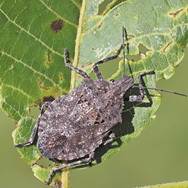Combat brown marmorated stink bug with lots of caulk FALL INVADERS

Joe Boggs
OSU Extension
By Linda C. Dolak
OSU master gardener volunteer
Before the 1990s, the brown marmorated stink bug was not found in the United States. It arrived accidently in a shipment from Asia. We do have many native stink bugs, but they have different features. The BMSB (Halyomorpha halysis) has distinctive, striped antennae, rounded shoulders, and dark and light banding on the abdomen. It is invasive, attacks many crops and overwinters in homes. Although the BMSB has been found in many states, it appears the most-severe plant issues with these bugs are found in the mideastern states, including parts of Ohio and Pennsylvania.
The brown marmorated stink bug adults are just less than 1 inch long, and have shades of brown on both its upper and lower body surfaces. They are shaped like a shield, and are almost as wide as they are long. To distinguish the BMSB from other stink bugs, look for lighter (white) bands on the antennae and darker bands on their membrane parts at the rear of the front paid of wings. They have small rounded depressions of coppery or bluish color on the head and parts of the body.
So, what’s all the stink about? These stink bugs have piercing-sucking mouthparts (similar to a drinking straw) that cause major damage to crops and severe economic losses. The BMSB feeds on fruits, vegetables, ornamental trees and shrubs, and seed pods of many plants. The first damage by this bug in Pennsylvania occurred on ornamental plants, such as butterfly-bush, empress tree and backyard peach and pear trees. In 2006, commercial growers began to see damage to their apple and pear trees and soybean fields. The BMSB continues to expand its presence.
Eggs are laid on the underside of leaves in late spring and early summer. It goes through five immature stages that feed throughout summer. Older nymphs resemble the adults, making them true bugs. Adults appear in late summer through winter, and appear in spring to lay eggs.
The insect must find shelter during winter, usually staying in homes, garages or barns. They really cause upset when they invade the home, but they will not reproduce or cause damage inside the structure. The smell of the BMSB is somewhat earthy, often being compared to cilantro. Their smelly liquid is excreted in defense from the underside of their thorax when they feel threatened. The bugs are attracted to the outside of houses on warm fall days, sometimes attracting so many that they begin to invade the home. To prevent entry, fill in cracks around baseboards, windows, exhaust fans, or lights in ceilings. Get a caulking gun and lots of tubes of caulking. Use this now to fill all holes so you don’t get tons of these bugs this fall.
They don’t spread on their own. Surprisingly they “catch a ride” on vehicles, suitcases, and even on our trusty U.S. mail. Thus, this bug can move from a highly infested area to a new area very quickly.
The BMSB is not normally harmful to humans, but those who are allergic to the scent of cockroaches and lady beetles may be affected. Also, if the beetle is crushed on exposed skin, it has been reported to cause dermatitis (inflammation on the skin) at the point of contact.
It is not advisable to use insecticides inside because the insecticide may eventually cause more problems for the homeowner, including negative effects on the health of humans. Exclusion (thus the caulking gun) is the best option for homeowners.
For photos and to learn how to keep them out of your home, go to: http://go.osu.edu/stinkybugs.
 43
43
